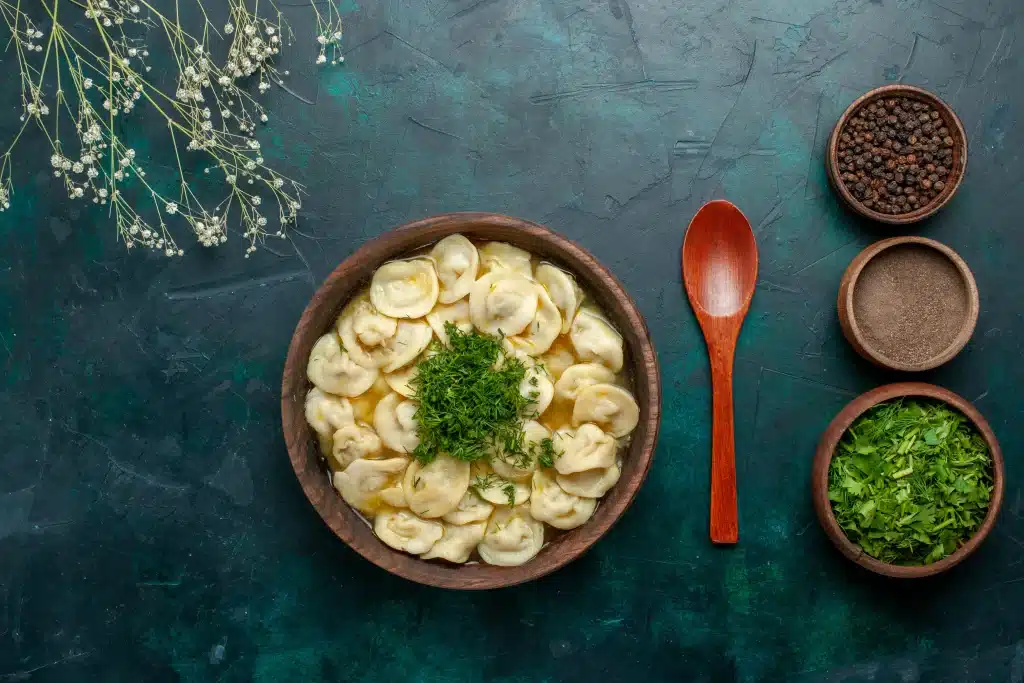Soup dumplings, known as xiaolongbao in Chinese cuisine, are a delicacy that has captured hearts worldwide. Originally from the Jiangnan region, particularly Shanghai, these small bundles of flavor have evolved over the years. Traditional dumplings are filled with pork, but with the growing popularity of vegetarian and vegan diets, meatless versions have taken the spotlight. Vegetarian soup dumplings are a modern reinvention that offers all the taste and texture of the original, but with plant-based ingredients. This shift toward vegetarian options not only meets demands for health and sustainability but also introduces a new and exciting range of flavors.
Essential Ingredients for Vegetarian Soup Dumplings
The key to good vegetarian soup dumplings lies in selecting fresh, high-quality ingredients. Here are the basic ingredients needed to prepare this dish:
Dumpling Wrappers:
Can be homemade or store-bought, typically made from flour and water.
Filling:
- Firm Tofu: Crumbled to mimic the texture of meat.
- Shiitake Mushrooms: For their umami flavor, adding a delightful depth.
- Napa Cabbage: Finely chopped, adds freshness and a crunchy texture.
- Ginger and Garlic: For a spicy and aromatic touch.
- Green Onions: Finely chopped, adding freshness and flavor.
- Soy Sauce and Sesame Oil: For seasoning.
Vegetable Broth Gelatin:
- Vegetable Broth: Concentrated and cooled to form the gelatin that will create the “soup” inside.
- Agar-Agar: A natural gelling agent that keeps everything vegan.
Step-by-Step: Preparing Vegetarian Soup Dumplings
Preparing vegetarian soup dumplings can be a rewarding process, though it requires attention to detail to achieve the perfect balance of flavor and texture. Below is a detailed explanation of each step:
Prepare the Broth Gelatin:
- Start with the vegetable broth: Choose a rich, flavorful vegetable broth as this will be the base of your soup inside the dumplings. You can make your own broth using a variety of vegetables like carrots, celery, onions, and garlic, simmered together for several hours to extract the maximum flavor. Alternatively, you can use a high-quality store-bought broth.
- Add the agar-agar: Agar-agar is a plant-based gelatin derived from seaweed, making it perfect for vegan and vegetarian dishes. Dissolve the agar-agar powder in the hot broth according to the package instructions. Typically, you’ll need about 1 teaspoon of agar-agar powder per cup of broth.
- Set the gelatin: Once the agar-agar is fully dissolved, pour the broth into a shallow dish and refrigerate it for about 1-2 hours or until it solidifies into a firm gelatin. The gelatin should be firm enough to cut into small cubes but still soft enough to melt once the dumplings are steamed.
Make the Filling:
- Prepare the tofu and mushrooms: Drain and press the tofu to remove excess moisture, then crumble it into small pieces. For the mushrooms, shiitake is ideal due to its deep, umami flavor. Clean the mushrooms, remove the stems, and finely chop the caps.
- Cook the filling: In a pan over medium heat, add a little oil and sauté the garlic and ginger until fragrant. Add the crumbled tofu and chopped mushrooms, cooking until they release their moisture and begin to brown slightly. This should take about 5-7 minutes. Add finely chopped napa cabbage and continue cooking until the cabbage is wilted and all the ingredients are well combined.
- Season the filling: Pour in the soy sauce and a small drizzle of sesame oil. Stir everything together, making sure the flavors are evenly distributed. Let the filling cool completely before proceeding.
Combine Filling with Broth Gelatin:
- Cut the gelatin: Once the broth gelatin has set, cut it into small cubes, about 1 cm each. These cubes will melt during steaming, creating the soup inside the dumplings.
- Mix with the filling: Gently fold the gelatin cubes into the cooled filling mixture. Be careful not to break the gelatin too much, as you want the cubes to remain intact to ensure a good amount of broth inside each dumpling.
Assemble the Dumplings:
- Prepare the wrappers: If using store-bought wrappers, make sure they are fresh and pliable. If making them at home, roll the dough into small circles, about 3 inches in diameter. The edges should be thinner than the center, which helps in forming a strong seal when pleating.
- Fill the dumplings: Place a dumpling wrapper on the palm of your hand and spoon a small amount (about 1 tablespoon) of the filling mixture into the center. Be careful not to overfill, as this can make the dumplings difficult to seal.
- Pleat and seal: Gather the edges of the wrapper and pleat them together at the top, pinching firmly to seal. The goal is to create a small, tightly sealed pouch that holds the filling and gelatin inside. You should aim for about 12-18 pleats per dumpling. Ensure there are no openings where the broth could leak out during steaming.
Steam the Dumplings:
- Prepare the steamer: Line a bamboo or metal steamer with parchment paper or cabbage leaves to prevent sticking. Arrange the dumplings in the steamer, leaving some space between each one to allow for expansion during cooking.
- Steam: Bring a pot of water to a boil, then reduce to a medium simmer. Place the steamer over the pot, cover, and steam the dumplings for about 8-10 minutes. The dumpling wrappers should become translucent and slightly glossy when done, and the filling inside should be hot and steamy.
Serve Immediately:
- Careful handling: Once steamed, handle the dumplings carefully as they are delicate and contain hot broth. Serve them in the steamer or transfer them gently to a serving plate.
- Eating tip: Instruct your guests to take a small bite from the top, sip the hot broth carefully, and then enjoy the rest of the dumpling in one or two bites.
Tips and Tricks for Perfect Dumplings
- Handling the dough: Keep the dough and dumplings covered with a damp cloth to prevent them from drying out while you work.
- Gelatin formation: Make sure the gelatin is well set before mixing it with the filling; otherwise, the dumplings won’t have the desired “soup” effect.
- Heat control: When steaming, it’s important to maintain a consistent temperature. Too high heat can break the dough, while low heat may result in undercooked dumplings.
How to Accompany Vegetarian Soup Dumplings?
Vegetarian soup dumplings are as versatile as they are delicious. Here are some suggestions for accompaniments:
- Sauces: Serve with a mix of rice vinegar, soy sauce, and a dash of chili oil to enhance the flavors.
- Steamed Vegetables: Bok choy, asparagus, or bamboo shoots are light accompaniments that complement the richness of the dumplings.
- Miso Soup: A bowl of miso soup can be served as an appetizer or side, adding a subtle umami flavor.
The Best Way to Serve Them
For the best experience with vegetarian soup dumplings:
- Serve hot: These dumplings should be served immediately after steaming, when the dough is soft and the broth is still liquid.
- Presentation: Place them in a bamboo steamer or on a slightly elevated plate to prevent sticking and maintain presentation.
- Eating instructions: Instruct your guests to bite a small hole at the top to sip the broth before eating the rest of the dumpling.
Ideal Times to Enjoy Vegetarian Soup Dumplings
Vegetarian soup dumplings are perfect for various occasions:
- Light lunches or brunches: They are light enough to enjoy mid-morning or at an informal lunch.
- Dinners: As an appetizer or main course, accompanied by other light dishes.
- Social gatherings: They are ideal for sharing at a family meal or among friends, allowing everyone to try a unique and flavorful bite.





